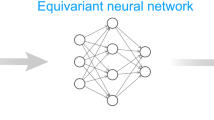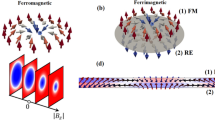Abstract
We give a theoretical study on the magnetic properties of monolayer nanodisks with both Heisenberg exchange and Dzyaloshinsky–Moriya (DM) interactions. In particular, we survey the magnetic effects caused by anisotropy, external magnetic field, and disk size when DM interaction is present by means of a new quantum simulation method facilitated by a self-consistent algorithm based on mean field theory. This computational approach finds that uniaxial anisotropy and transversal magnetic field enhance the net magnetization as well as increase the transition temperature of the vortical phase while preserving the chiralities of the swirly magnetic structures, whereas when the strength of DM interaction is sufficiently strong for a given disk size, magnetic domains appear within the circularly bounded region, which vanish and give in to a single vortex when a transversal magnetic field is applied. The latter confirms the magnetic skyrmions induced by the magnetic field as observed in the experiments.













Similar content being viewed by others
References
Bode M, Heide M, von Bergmann K, Ferriani P, Heinze S, Bihlmayer G, Kubetzka A, Pietzsch O, Bluegel S, Wiesendanger R (2007) Chiral magnetic order at surfaces driven by inversion asymmetry. Nature 447:190–193
Choe SB, Acremann Y, Scholl A, Bauer A, Doran A, Stöhr J, Padmore HA (2004) Vortex core-driven magnetization dynamics. Science 304:420–422
Dzyaloshinsky IE (1958) A thermodynamic theory of weak ferromagnetism of antiferromagnetics. J Phys Chem Solids 4:241–255
Fert A (1990) Magnetic and transport properties of metallic multilayers. Mater Sci Forum 59–60:439–480
Fert A, Cros V, Sampaio J (2013) Skyrmions on the track. Nat Nanotechnol 8:152–156
Gong M, Qian Y, Yan M, Scarola VW, Zhang CW (2015) Dzyaloshinskii–Moriya interaction and spiral order in spin-orbit coupled optical lattices. Sci Rep 5:10050
Heide M, Bihlmayer G, Blügel S (2008) Dzyaloshinskii-Moriya interaction accounting for the orientation of magnetic domains in ultrathin films: Fe/W(110). Phys Rev B 78:140403(R)
Heinze S, Von Bergmann K, Menzel M, Brede J, Kubetzka A, Wiesendanger R, Bihlmayer G, Blügel S (2011) Spontaneous atomic-scale magnetic skyrmion lattice in two dimensions. Nat Phys 7:713–718
Im MY, Fischer P, Yamada K, Sato T, Kasai S, Nakatani Y, Ono T (2012) Symmetry breaking in the formation of magnetic vortex states in a permalloy nanodisk. Nat Commun 3:983
Kiselev NS, Bogdanov AN, Schäfer R, Rößler UK (2011) Chiral skyrmions in thin magnetic films: new objects for magnetic storage technologies. J Phys D 44:392001
Kwon HY, Bu KM, Wu YZ, Won C (2012) Effect of anisotropy and dipole interaction on long-range order magnetic structures generated by Dzyaloshinskii–Moriya interaction. J Magn Magn Mater 324:2171–2176
Liu ZS, Sechovský V, Diviš M (2011) Magnetism of PrAl\(_2\) nanoparticle investigated with a quantum simulation model. J Phys Condens Matter 23:016002
Liu ZS, Sechovský V, Diviš M (2012) Magnetism of DyNi\(_2\)B\(_2\)C nanoparticle investigated with a quantum simulation model. Phys Status Solidi B 249:202–208
Liu ZS, Sechovský V, Diviš M (2014) Mutual verification of two new quantum simulation approaches for nanomagnets. Phys E 62:123–127
Luo YM, Zhou C, Won C, Wu YZ (2014) Effect of Dzyaloshinskii Moriya interaction on magnetic vortex. AIP Adv 4:047136
Ma FS, Zhou Y, Braun HB, Lew WS (2015) Skyrmion-based dynamic magnonic crystal. Nano Lett 15:4029–4036
Moriya T (1960) New mechanism of anisotropic superexchange interaction. Phys Rev Lett 4:228–230
Mühlbauer S, Binz B, Jonietz F, Pfleiderer C, Rosch A, Neubauer A, Georgii R, Böni P (2009) Skyrmion lattice in a chiral magnet. Science 323:915–919
Münzer W, Neubauer A, Adams T, Mühlbauer S, Franz C, Jonietz F, Georgii R, Böni P, Pedersen B, Schmidt M, Rosch A, Pfleiderer C (2010) Skyrmion lattice in the doped semiconductor Fe\(_{1-x}\)Co\(_x\)Si. Phys Rev B 81:041203(R)
Rohart S, Thiaville A (2013) Skyrmion confinement in ultrathin film nanostructures in the presence of Dzyaloshinskii–Moriya interaction. Phys Rev B 88:184422
Sampaio J, Cros V, Rohart S, Thiaville A, Fert A (2013) Nucleation, stability and current-induced motion of isolated magnetic skyrmions in nanostructures. Nat Nanotechnol 8:839–844
Shinjo T, Okuno T, Hassdorf R, Shigeto K, Ono T (2000) Magnetic vortex core observation in circular dots of permalloy. Science 289:930–932
Skyrme THR (1962) A unified field theory of mesons and baryons. Nucl Phys 31:556–569
Thiaville A, Rohart S, Jué E, Cros V, Fert A (2012) Dynamics of Dzyaloshinskii domain walls in ultrathin magnetic films. Europhys Lett 100:57002
Tonomura A, Yu X, Yanagisawa K, Matsuda T, Onose Y, Kanazawa N, Park HS, Tokura Y (2012) Real-space observation of skyrmion lattice in helimagnet MnSi thin samples. Nano Lett 12:1673–1677
Wachowiak A, Wiebe J, Bode M, Pietzsch O, Morgenstern M, Wiesendanger R (2002) Direct observation of internal spin structure of magnetic vortex cores. Science 298:577–580
Wilhelm H, Baenitz M, Schmidt M, Röler UK, Leonov A, Bogdanov AN (2011) Precursor phenomena at the magnetic ordering of the cubic helimagnet FeGe. Phys Rev Lett 107:127–203
Yu XZ, Onose Y, Kanazawa N, Park JH, Han JH, Matsui Y, Nagaosa N, Tokura Y (2010) Real-space observation of a two-dimensional skyrmion crystal. Nature 465:901–904
Yu XZ, Kanazawa N, Onose Y, Kimoto K, Zhang WZ, Ishiwata S, Matsui Y, Tokura Y (2011) Near room-temperature formation of a skyrmion crystal in thin-films of the helimagnet FeGe. Nat Mater 10:106–109
Acknowledgments
Z.-S. Liu acknowledges the financial support by National Natural Science Foundation of China under grant No. 11274177. H. Ian is supported by the FDCT of Macau under Grant 013/2013/A1, University of Macau under Grants MRG022/IH/2013/FST and MYRG2014-00052-FST, and National Natural Science Foundation of China under Grant No. 11404415.
Author information
Authors and Affiliations
Corresponding author
Rights and permissions
About this article
Cite this article
Liu, Z., Ian, H. Effects of Dzyaloshinsky–Moriya interaction on magnetism in nanodisks from a self-consistent approach. J Nanopart Res 18, 9 (2016). https://doi.org/10.1007/s11051-015-3311-z
Received:
Accepted:
Published:
DOI: https://doi.org/10.1007/s11051-015-3311-z




